

Rose Care

Month-By-Month Rose Care Calendar
Synthetic and Organic Rose Care
This page offers a guide for caring for roses on a month-to-month basis, for both Synthetic Rose Care, using most commercially-available rose care products, and for Organic Rose Care (in Southern California). Organic rose care calendar materials are by Paulette Moucher, American Rose Magazine, March 2012, pp. 31-32. Additional information is available in the OCRS monthly newsletter, which you will receive as an OCRS member!
Synthetic Rose Care
January:
Pruning, Bare Roots, Repotting and Renewal

This month we force the roses into dormancy. How is this done? Pruning each bush back and removing all foliage forces the energy of growing back into the roots and canes. You should always start with clean sharp bypass pruners. Seal large canes with white glue. Clean all debris under each bush. The final step will be using a dormant spray such as copper sulfate and/or horticulture oil to prevent disease and pests on the new growth. Finish the job with a 3 inch layer of mulch. Need a new rose? It's bare root rose season! Nurseries are ripe with young plants. Roses are rated in size. Stick with Grade 1 or 1.5 as they will have the best cane size. Canes should look healthy and green. If the canes are shriveled, do not purchase this plant. It is very dehydrated and will have a difficult time thriving. While the weather is cool and the roses are quiet, January also is an ideal time to repot roses. Potted roses need soil renewal every 2 to 3 years since it becomes depleted as the soil level slowly drops away. Always start with potting soil rich with organic matter with a soil pH around 6.5. Do not fertilize your roses immediately after pruning. When there is 3 inches of new growth, then you should fertilize.
Organic Rose Care
Prune roses, pull off all leaves, remove fallen debris. Plant bare roots. Apply 2 tbsp John and Bob's Soil Optimizer, 2 C Biosol/rose and scratch in lightly, and dormant spray. For fertilization, apply 2 C Dr. Earth Rose Fertilizer or equivalent/rose and scratch in lightly.
Rose pictured: Solar Flair (MiniFlora). Photo credit: Justin Ekuan
February:
New Growth and
Finish Pruning

Synthetic Rose Care
The weather will remain cool and growth will come slowly. Roses require a soil temperature of 60 degrees F to grow. Roses in pots will resume their growth quicker as the sun can warm the soil easier. Some rosarians like to start all new plants in pots to see how they perform as well as giving them a chance to get a good head start. It is far easier to remove a poor performer from a pot than to dig it out of the ground. It still is not too late to prune. Some rosarians believe the later you prune, the less disease you will encounter as the rainy season ends and prevents that ideal symbiosis of damp nights and warm days that lead to mildew and rust. It is still advised that a dormancy spray still be used regardless of when you prune.
Organic Rose Care
Finger prune side growth and remove side growth. If aphids appear, wash them off with a water blast.
Rose pictured: Souvenir d'Adlophe Turc (Polyantha). Photo credit: Justin Ekuan
Synthetic Rose Care
March:
Rebirth and Fertilization

The weather gets warmer and the sun graces us longer. This is the time to admire the new growth and buds! Some gardeners are lucky by month's end to see the first blooms. Due to their slow growth, these first blooms will be your biggest for the year. When your plants have 3 inches of new growth, fertilizer may be added. Organic fertilizers release slowly and gently feed the plants. Inorganic fertilizers rapidly release and will need more frequent use. Whatever type you use, the package will describe the amount and frequency at which it should be applied. Do not feed and starve your plants! They will reward you with frustration, disease and little or no blooming. An easy program is to get a three-month time released rose fertilizer. Every time you water the rose, it gets fed. A good way to remember is March, June and September for the feeding schedule--a changing of the season, a change of food. Three times per year may be all that is needed with a good time-release fertilizer. Easy! Each fertilizer has a three-digit rating called an N-P-K rating. This stands for Nitrogen-Phosphorus-Potassium. Each is a key ingredient to rose development. Nitrogen is the key to green growth and leaves. Early season feeding should gear towards this as you do not want to encourage early bloom, only leading to short stems and big flowers. Phosphorous is important for bloom production. Potassium creates strong canes to support those lovely flowers. Indoor plant food cannot be used on roses. The result would be a lush green plant with no blooms. Look for a fertilizer designed for roses or ornamental flowering plants. Contact the Orange County Rose Society if you need help to guide you.
Organic Rose Care
Mulch roses and apply Humic Acid, Also apply alfalfa tea or liquid organic fertilizer when roses have 4-6 inches of growth, Check for insect and pest infestation as well as fungal disease.
Rose Pictured: Lady of the Dawn (Floribunda). Photo credit: Justin Ekuan
Synthetic Rose Care
By now you should have lots of buds and be anxiously awaiting the arrival of that marvelous color splash. Unfortunately, some outsiders may have discovered your rose buds, too. Aphids are common pests at this time of the year. These insects are usually green and are found on the buds and neck of the roses looking for tender growth upon which to feed. Quick fixes for this are taking the hose sprayer and blasting them off, squishing them with your fingers (best if done wearing gloves) or spraying with an insecticidal soap designed for this predator. Local sparrows and finches delight in eating these off your plants. Ladybugs and their larvae will help, but they do not stay long in your garden. Another annoyance may be small holes appearing on the leaves. These are caused by rose slugs -- larvae of the sawfly. They feast underneath the leaves. To locate them, follow the trail of holes up the plant until they stop. Turn over the leaf and you will see green caterpillar-like worms. To rid your garden of these you can once again squish them (which is very time consuming if you have many bushes) or spray underneath the leaves with an insecticide specific for this insect. The California rainy season will down soon, so vigilance with watering is a must.
Organic Rose Care
Apply 2C Dr. Earth Rose Fertilizer or equivalent/rose and scratch in lightly. Also apply 2 cups of Biosol/rose & scratch in lightly, Deadhead roses after bloom
April:
First Bloom and Pests

Rose pictured: The Impostor (Shrub). Photo credit: Dorothy Birsic
Synthetic Rose Care
May:
Disease Watch and Water
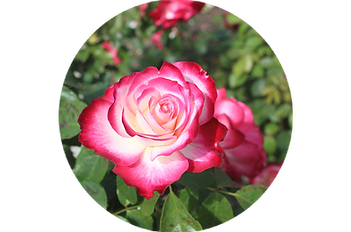
The first bloom cycle is over and now it is time to deadhead those spent blooms. Just as in pruning, cut back the old flower just above a five-leaflet that faces outward. Keep the center of the rose open all season to aid in air circulation. Another chore is to remove leaflets close to the ground to allow air circulation from underneath the plant. For hybrids teas, grandifloras, floribundas and climbers, clear 8 leaves from the bottom. For smaller plants such as miniatures or minifloras 3-4 is a good rule of thumb. Water your roses. How often? The warmer it gets, the more frequent this chore should be. Potted roses especially need to have frequent watering as they cannot draw from the soil like their in-the-ground counterparts can. Just like starving your roses of food, denying them of water will also cause your roses to shut down. A steady diet of water is a must. A quick rule to use: 70-80 degrees outdoor temperature - water twice a week, 80-90 degrees outdoor temperature - water 3-4 times a week, 90 degrees and above - water daily, and above 100 degrees - water twice a day. It is hard to overwater roses if they are planted in loose, draining soil. Clay soil, which is prevalent in Orange County, will hold water and potentially suffocate the roots depriving them of oxygen. Clay soil can be amended to break down the clay with gypsum and compost. If you are having trouble, a visit from one of our Consulting Rosarians might help you.
Organic Rose Care
Apply fish emulsion to roses at a mix of 1tablespoon per gallon. Apply 1 gallon/large rose, and a half gallon for smaller roses.
Rose pictured: Cherry Parfait (Grandiflora). Photo credit: Dorothy Birsic
Synthetic Rose Care
Most in Southern California can expect the gray days of June, especially those living within 10 miles of the coast. Monitor closely for mildew. Once mildew is on your plant, you cannot kill it. The fungus has invaded the cells to help it grow. To help prevent further spread, it must be removed. After clipping off affected areas, disinfect your clippers before moving on to another bush. This can be done with a disinfectant wipe or a disinfectant spray, then dry the clippers. It is best to prevent mildew before it arrives. Fungicides are used to prevent mildew, rust, anthracnose, black spot and downy mildew. Consult with the Orange County Rose Society or your local nursery to find the product you need. There are also organic mildew sprays such as Neem Oil or potassium bicarbonate. Again, don't forget about water. Water in the morning hours so that the sun may dry the leaves, and this will help prevent fungus problems. Watering at night will add crucial moisture allowing the mildew to grow.
Organic Rose Care
Apply 2 cups of Dr. Earth Rose Fertilizer or equivalent/rose and scratch in lightly.
June:
June Gloom
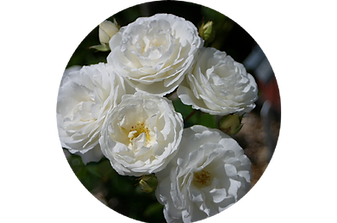
Rose picture: Pillow Fight (Shrub). Photo credit: Justin Ekuan
Synthetic Rose Care
Did we mention watering your roses? Grasshoppers are elusive creatures that frustrate gardeners. On roses, they will chomp at the buds and eat the leaves leaving an irregular border. Other than birds catching them, you'll need to catch them from behind and chop their heads off to kill them. They also can hide behind fences. Spraying the plants with water can flush them out so keep your shears close to nab them. Their outer skin (exoskeleton) is tough and rather impervious to pesticides.Spraying roses in hotter weather requires a little more TLC. Make sure your plant is watered prior to starting. Using half-strength sprays will be less harsh. If the temperature is over 85 degrees F do not spray. Two new visitors may be visiting your garden about this time. Thrips are very tiny insects found deep within the petals. They are 1/16 inch long and typically seen in the light colored roses. Their damage will be seen with a slight brown edging to the petals. Drenching the buds with spinosad will help eliminate them. The second problem is spider mites. They nest underneath the leaves. If you rub under the leaves and notice a gritty feel, they are there. Long term damage will include dying leaves and defoliation. An easy solution is to blast the undersides of the leaves with water. When the underside feels smooth, you have removed these mites. A miticide will also remove these critters.
Organic Rose Care
Continue to water roses as needed in hot summer months. Check for spider mites and use a water blast to remove.
July:
Water, Grasshoppers and New Pests
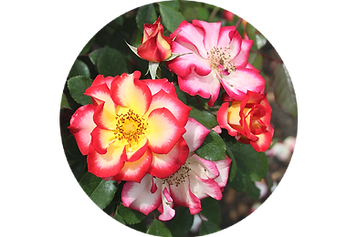
Rose pictured: Betty Boop (Floribunda). Photo credit: Dorothy Birsic
Synthetic Rose Care
Roses can get a bit tall by summer's end. A light pruning will help bring them back to earth. This time you do not remove the leaves! By taking the top one-third of the rose off, energy is signaled back to the canes, slowing the push to bloom and therefore bringing bigger fall roses. You may want to check for beetles. Japanese beetles are not found in Southern California. The Fig Beetle is similar but more than twice the size and may be seen in your garden. They will chew on roses.
Organic Rose Care
Mid to late month prune 1/3 rose plant back. Apply 2 tablespoons of John & Bob's Soil Optimizer/rose and scratch in lightly. Apply 2 cups of Dr. Earth Rose Fertilizer or equivalent/rose and scratch in lightly. Apply 2 cups Biosol/rose.
Rose pictured: Over the Moon. Photo credit: Justin Ekuan
August:
Minor Pruning
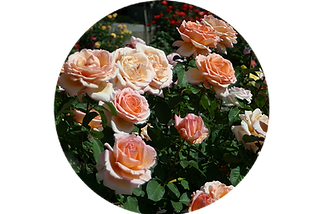
September:
More Pests
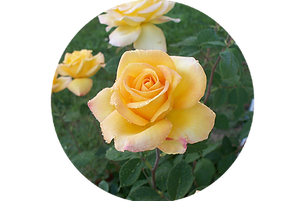
Synthetic Rose Care
Cooler nights are coming soon. Aphids may return so follow the program outlined in April to rid your garden of them. There also may be different holes in the leaves of the rose plants. If there are big round ones, they are made by the cutter bee. The bees are taking the leaves and lining their nests. Cutter bees look like black honey bees, and it is fascinating to watch how they make a perfect circle cut in the leaf. Small holes in the buds are usually are from caterpillars. It is recommended that you remove these buds.
Organic Rose Care
Apply alfalfa tea or liquid organic fertilizer.
Rose pictured: Gold Medal (Grandiflora). Photo credit: Dorothy Birsic
October:
Final Feeding and Rose Shows
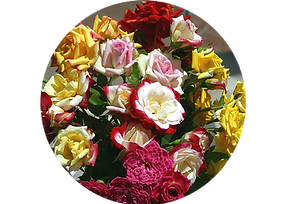
Synthetic Rose Care
In preparation for the winter hibernation of the rose, you want to let the rose know it is time to slow down. October is the last month to feed your roses. Less food equals less growth. As the nights are cooler, the roses will not rebloom as quickly. Fall blooms are definitely larger than summer's. Keep your plants well hydrated ahead of Santa Ana conditions which can dehydrate plants very quickly and stress the roses. Stress may lead to more disease as the rose tries to recover. Late September and October are rose show times in Southern California. These shows are usually free to the public for viewing after judging has finished. Visiting one of these shows can give you an idea of the selection of the many types of roses that can be grown in our area including polyanthas, shrub roses, hybrid teas, floribundas, miniature roses and mini-floras, etc. Many of these will fit in even small garden spaces, and they can be disease-resistant prolific bloomers.
Organic Rose Care
Apply 2 cups Dr. Earth Rose Fertilizer or equivalent/rose & scratch in lightly
Roses pictured: Mixed boquet of Miniatures and MiniFloras. Photo credit: Justin Ekuan
November:
Last Call
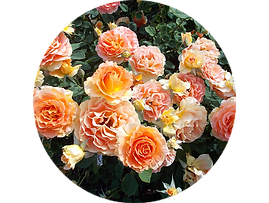
Synthetic Rose Care
Depending on the weather, roses may still be blooming in November. A bouquet of orange and yellow roses look lovely on the Thanksgiving table. Keep watering until the rains start. Having a rain gauge will give you an idea of how much water your garden has received.
Organic Rose Care
Stop deadheading and pull off old petals. Water less.
Rose pictured: Brass Band (Floribunda). Photo credit: Dorothy Birsic
Prune roses, pull off all leaves, remove fallen debris. Plant bare roots. Apply 2 tbsp John and Bob's Soil Optimizer, 2 C Biosol/rose and scratch in lightly, and dormant spray. For fertilization, apply 2 C Dr. Earth Rose Fertilizer or equivalent/rose and scratch in lightly.
Organic Rose Care
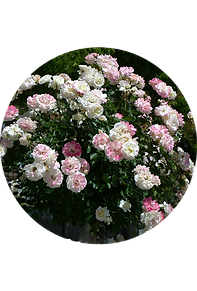
December:
Rest and Planning
Synthetic Rose Care
Like the end of the calendar, it is the end of the rose season, with some late blooms appearing. Instead of cutting back or dead heading, remove the spent petals and leave the growing rose hips to add some late season green, red or orange fruit on your plants. This will also signal your plants to rest. Heavy garden gloves, pruners and kneeling benches make wonderful holiday gifts for any gardener. Rose catalogs are out around December, and it may be a good time to see if there are roses you'd like to remove and replace with a fresh plant or two. Not all roses will grow well in our diverse Orange County climate. Generally, we have 2 climates to work around. First is the coastal area which is ripe with overcast/foggy mornings. Less sunlight available makes it harder to grow heavily-petaled roses. If you find yourself in this area, roses with 25 petals or less are ideal as well as very disease resistant plants. Mildew is a big problem along the coast. Next is the inland climate where there is plenty of sunshine and hotter temperatures. This area can grow roses with greater than 25 petals. Look for roses that can take those 100 degree + temperatures.
Organic Rose Care
Stop deadheading and pull off old petals. Water less.
Rose pictured: Easter Basket. Photo credit: Justin Ekuan
Rose calendar digital artwork at top of page features Paris de Yves St. Laurent (Hybrid Tea). Image by Dorothy Birsic
